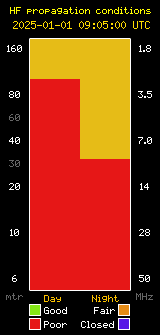Sometimes you come to realise that the simplest, original discoveries just stand the test of time, and there's little point looking for an 'upgrade'. That's why I've held on to my first wife for so long, despite the deteriorating audio output.
The same is not typically true of digital technology, as we're forever telling Russell.
However, going back to first principles is usually a great place to start when you're tackling something new or refreshing long neglected skillsets.
My personal journey and this particular technology have never crossed paths and that's a shame, but it feels a bit like an old friend all the same. I'm talking about RTTY, or Radio Teletype.
Radio Teletype was 'invented' in 1922 by the US Navy, and it was way ahead of its time. It's quite amazing that it's still around today albeit in a slightly different format. This is a terrific endorsement of its simplistic and therefore fundamentally robust architecture, and is a refreshing alternative to some of the proprietary tosh being touted around the world of digital radio today.
Of course, some of you will be spitting at the screen and muttering something about CW, and I'm certainly not trying to decry the incomparable digital daddy, but RTTY was one of the very first recognisable M2M computer protocols.
This is not meant to be a history lesson, but rather an attempt to contextualise my preoccupation with re-visiting RTTY without prejudice.
Why would I even want to do this? I guess the stock answer would be 'well, why not?', but in my case there is a compelling requirement at the heart of my ongoing research and development project to transpose a simplistic messaging system onto a modern, robust and secure radio communications protocol. More of that another time maybe, but here we are unapologetically blowing the cobwebs off of two bits of software called flrig and fldigi.
So having covered my ignorance of all things RTTY upfront, here is just a snapshot of where I got to over the past weekend. There was actually plenty of RTTY action on 40m, and (thankfully) it didn't even seem to be because of a contest. A great opportunity then to try some decoding.
After the not insignificant task of configuring the software to work with my radio, I was very happy to snatch my first strings of intelligible data out of the air, quickly followed by the sending of some of my own. That was a bit daunting, I can tell you, and I did elicit a couple of 'THIS FREQUENCY IS IN USE!" responses whilst trying to navigate the very congested RTTY spectrum. Ho hum. That's what happens when you try out a new mode on a new radio and with several bits of 'new' software I guess, but how else are you going to figure all this stuff out?
Well, for good measure, I also found out that RTTY CQ calls are spotted on the Reverse Beacon Network, so another new experience for me.
I'm having so much fun right now. There is way too much cool stuff to learn in this hobby, and I'm furiously trying to soak it all up like Spongebob Squarepants on steroids.
Whatever you're doing in radio these days, I hope you're enjoying it half as much as I am. If you're not, then try something different! Learning a new skill is remarkably rewarding.




